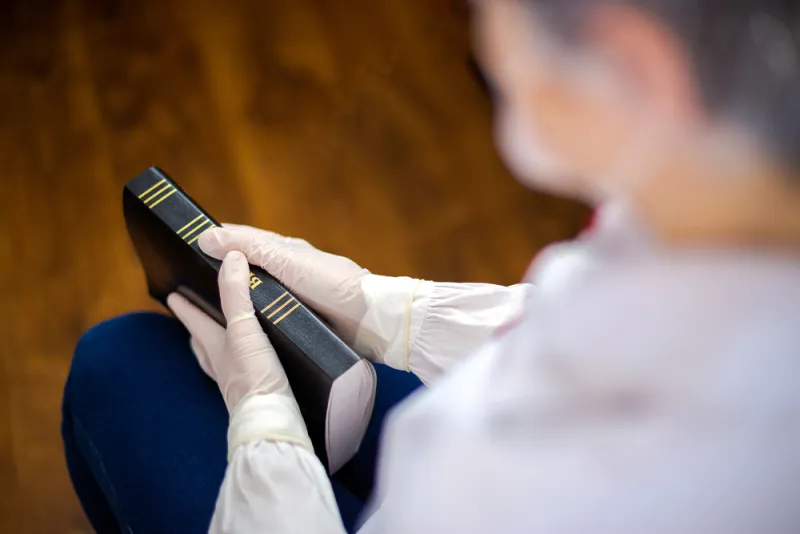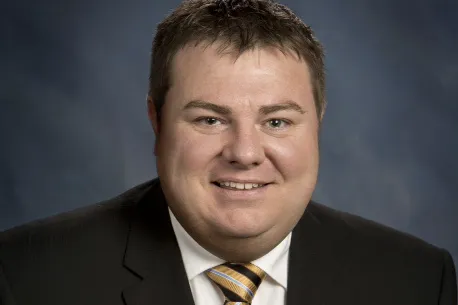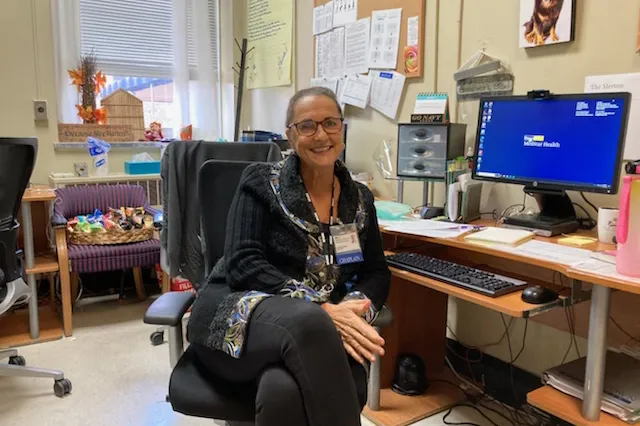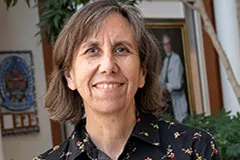
St. Louis, Mo., Nov 17, 2022 / 07:00 am (CNA).
The U.S. bishops on Wednesday voted to move forward with the creation of a new prayer book for laypeople who work among the sick.
Since the book still needs the approval of the Vatican, it might be a year or two before it hits the shelves. But several lay chaplains whom CNA spoke to are already expressing interest.
Moira Bucciarelli, a lay Catholic chaplain who ministers in Maryland, said she does not often use prayers from a book, preferring to “pray from the heart, spontaneously,” but occasionally she will pray prayers she finds online, she said.
She affirmed that there is a need for the prayer book that the bishops have now decided to create.
“I like the concept of it — having specifically Catholic prayers, perhaps for different occasions, all in one resource. That sounds great to me,” she said. “I would love it if there were more Catholic resources for chaplains.”
Only priests are allowed to perform the sacrament of anointing of the sick, which can be administered whether or not the sick person is in danger of death with the hoped-for effect of physical and spiritual healing. But there are several liturgical books — including the book used for the anointing of the sick — that include material that is specifically designed to be used by laypeople when a priest isn’t available.
Father Andrew Menke, executive director of the U.S. bishops’ Secretariat of Divine Worship, told CNA that he hopes the potential new prayer book will be helpful for laypeople who want to minister to the sick.
“A pastor can put this book into the hands of the folks who help him in visiting the nursing homes, hospitals, and places where there isn’t a priest-chaplain every day, but there might be a layperson there,” Menke said.
The compiled prayers are drawn from at least four books that are typically used by priests in their ministry to the sick. The prayers are not “new,” but because the prayer book is part of an ongoing project by the bishops to revise all liturgical translations for accuracy, all the source material for this book has been newly translated from Latin in the past five years or so, Menke said.
There already exists an “unofficial” compilation of such prayers called “A Ritual for Laypersons: Rites for Holy Communion and the Pastoral Care of the Sick and Dying,” published by Liturgical Press in 1993.
Joshua Allee, a lay Catholic chaplain of 16 years who lives in St. Louis, told CNA that he sees the potential new prayer book as a good idea and a potentially useful resource for laypeople ministering to the sick. Allee said oftentimes when praying with a patient, he prays with him or her “from the heart” and often ends with an Our Father or Hail Mary, but only after “reading the room” and determining what the patient and his or her family would be most comfortable with.
He said he also uses the prayers for laypeople contained in “Anointing of the Sick and their Pastoral Care,” a priest-centric volume commonly referred to as the “green book.” When administering holy Communion to a patient, those prayers come straight from the book, he said, and his copy is heavily dog-eared on the relevant pages — though he also has many of the prayers memorized by now after a decade and a half of ministry.

Joshua Allee. Courtesy photo
A book compiling all the lay prayers would be a useful item to “throw in your satchel” when hustling to an emergency situation, he said, and would also be valuable for younger chaplains who don’t yet have the prayers memorized.
Allee serves as regional vice president of mission integration for SSM Health St. Louis, a Catholic health care system. His job, he says, is to keep alive the Catholic charism of the nuns who founded the hospital system.
He noted that the “Ethical and Religious Directives for Catholic Health Care Services” — the document from the U.S. bishops that governs Catholic health care — has an entire section on the pastoral and spiritual responsibilities of Catholic health care institutions to their patients.
These include a mandate to make sacraments such as Communion, reconciliation, the anointing of the sick, and confirmation available to patients who ask for them; there are Catholic priests on call, and Masses are offered at the hospital at least weekly, if not more often. In addition, he said, they keep a Rolodex of Protestant clergy, rabbis, and imams to ensure that they can provide spiritual care to people of all faiths.
“Pastoral care encompasses the full range of spiritual services, including a listening presence; help in dealing with powerlessness, pain, and alienation; and assistance in recognizing and responding to God’s will with greater joy and peace,” the directives read.
‘Overall well-being’
Laura Fetters, who serves at MedStar Georgetown University Hospital in Washington, D.C., taught English and religion at Catholic schools in the Archdiocese of Washington for 35 years before making the pivot to chaplaincy; she will be eligible for board certification in 2023. She said a pivotal moment in her journey toward this career was the death of her father in 2013.
“I paid close attention to the work of the hospice care team and also reflected on the role of the chaplain who came to minister to our family during that hard time. That was probably the first time the seed was planted for chaplaincy work,” Fetters told CNA.

Laura Fetters, a lay Catholic hospital chaplain, in her office in Washington, D.C. Courtesy photo
She said a day at work for her usually begins with a report about what has gone on during the night — updates on patients, emergencies, deaths. Chaplains are assigned units in the hospital, and Fetters said they make sure that each patient has a chaplain visit as soon as reasonably possible once they have been admitted.
“In general, most people are welcoming. Many are lonely and anxious. Some might also appear curious because they have never been visited by a chaplain before so they wonder if they are going to be “preached to or going to be made uncomfortable,” Fetters noted.
“Others automatically assume that we have been sent because their illness has reached a dire point; in this case we have to alleviate their fears and explain that we visit everyone in the mission of cura personalis — care for the whole person.”
Fetters said she prefers to pray a “personal, extemporaneous” prayer with the patients after conversing with the patients and learning about their families, concerns, and hopes. She said her prayers will include a request for blessings for the doctors and medical team, petitions for peace of mind and comfort for the patient and family members, gratitude for healing if appropriate, and expressions of trust in God’s mercy and compassion.
If the occasion arises to use a book of prayers, Fetters says she uses “A Ritual for Laypersons,” the unofficial — but still useful — prayer compilation mentioned earlier.
In the course of her work, she has come to realize that many patients “feel quite comforted by the presence of a Catholic lay chaplain; we (the patient and I) can create an emotionally safe space together where fears and anxieties can be shared.”
“To be clear, though,” she continued, “many conversations are also light because patients might want a distraction from the heaviness of their medical situations. Consequently, they talk about their dogs, their gardening, and their grandchildren. Typically, the patient should feel welcome to talk about whatever feels most healing and comfortable for him/her; sometimes a lay chaplain is a perfect fit for those situations.”
The presence of chaplains in a health care facility demonstrates that the mission of the program is a patient’s overall well-being, Fetters said.
“Chaplains minister to help patients access hope and experience compassionate spiritual care during treatment. Studies have indicated that a patient’s access to personal hope can be significant in overall healing and efficacy of medical treatment,” she noted.
Allee, the St. Louis chaplain, said he hopes to get the word out about the “great need” for lay chaplains to the sick. Certified Catholic chaplains are a “diamond in the rough” these days, he said, with by and large more retirements than new people joining the ministry. NACC says the average age of a professional chaplain in the U.S. is 64.
But Allee noted that chaplaincy is a real career and is very much appreciated by the patients he encounters. He said he’s received enough thank-you notes over the years to fill a large file drawer.
“It’s a true apostolate of the Church,” Allee said of lay chaplaincy.
Sharing God’s love
Bucciarelli says a big part of her job ithe outpatient chaplain at the Sidney Kimmel Comprehensive Cancer Center at Johns Hopkins University in Baltimore is simply making herself available to cancer patients and their caregivers, introducing herself to patients as a “spiritual resource.”
She often prays with patients, and leads retreats and performs blessings for staff. She does her ministry work alongside a Catholic priest as well as several colleagues of other faiths.

Bucciarelli recently became board-certified as a chaplain with the National Association of Catholic Chaplains, a body that collaborates with the U.S. bishops to train and certify chaplains both clerical and lay. Bucciarelli was able to do a three-month internship to assess whether the role would be a good fit for her.
“Chaplaincy offers women, lay Catholic women, wonderful opportunities for leadership in ministry,” she noted.
And although Johns Hopkins is not a Catholic hospital, Bucciarelli says, “It’s also the first job I’ve had where I feel like I can bring my whole self, including my faith-filled self, my love of God, into my workplace.”
If you value the news and views Catholic World Report provides, please consider donating to support our efforts. Your contribution will help us continue to make CWR available to all readers worldwide for free, without a subscription. Thank you for your generosity!
Click here for more information on donating to CWR. Click here to sign up for our newsletter.





When people go to hospital and need the last rites or sac.of the sick and confession they NEED A GOOD PRIEST NOT A FEEL GOOD SECESSION FROM A FEEL GOOD TREE HUGGER!!!